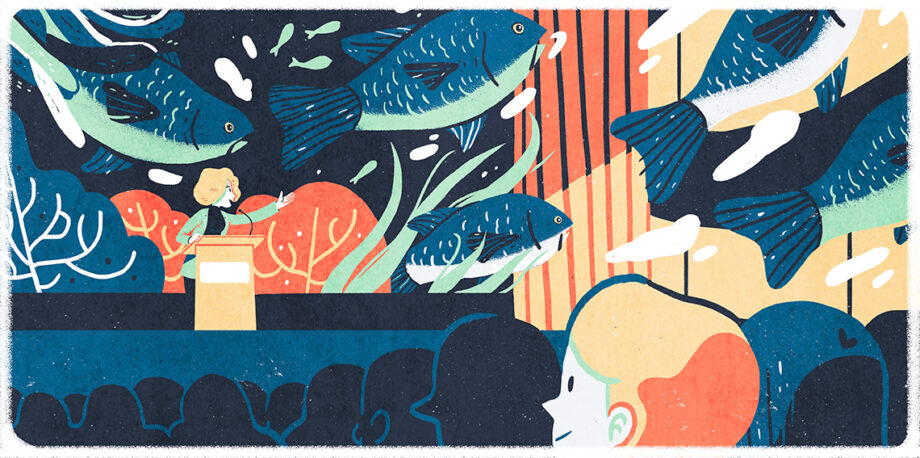June 10, 2014 — “What’s the most effective way to raise awareness of environmental issues and motivate people to take action?”
While pondering this question recently, I was reminded of a talk I saw several years ago that still ranks among the most powerful I’ve ever seen.
On a rainy day in the spring of 2011, I had the good fortune of driving legendary ocean explorer Sylvia Earle around Minneapolis–St. Paul for a series of meetings and media interviews prior to an event where she was the featured speaker.
Throughout the day as we traveled around the city, we discussed everything from our childhoods to our greatest hopes for the future and the environment. I have to admit, though, most of the time I was in awe, thinking, “One of the world’s preeminent environmental leaders and explorers is sitting in the front seat of my car chatting about her love of the ocean!” For that reason, most of the day was a blur.
It wasn’t until later in the evening that I would truly come to understand the power of her convictions.
That night, during her talk in front of an audience of nearly a thousand people, she said something I’ll never forget. Something that in many ways changed my life.
“Once you know,” she said, “there’s no excuse.”
She didn’t need to finish the thought — the message was clear as day (or in Earle’s case, clear as the bright, blue Caribbean). Once you know there’s a problem, once you see the problem and once you understand the problem, there’s no excuse not to act. You have to try to make a difference.
Organizations and individuals have long sounded the alarm and increased awareness of a host of environmental issues such as ocean pollution, climate change, species loss and deforestation, yet it often feels like we’re no closer to — or in some instances moving further away from — developing lasting solutions.
I’d been aware of the harm we as humans were causing the world’s oceans long before Earle’s talk, but it wasn’t until hearing her speak that the message truly hit home and I made a change.
For years up to that point, I’d been a pescetarian — a pseudo-vegetarian who indulged in the occasional salmon filet or shrimp kebab. But not after hearing Earle. The next day I stopped eating fish and seafood.
What was it about her message and approach that made it so compelling and made me move from awareness to action? I think there are a number of things she did that night that can inform others who wish to make a difference in the world and build that bridge between awareness and action. Here’s my top 10 list from the evening:
1. Tell great stories
Stories have the power to draw the audience in and help them understand your motivation and why you care. In Earle’s case, personal stories about having kids and taking her mother diving for the first time built a connection with the audience while breaking down and personalizing a topic as big as “the ocean.”
2. Show some passion
I’m not talking about hand waving or shouting, although that might have its place at times. Earle’s passion came through her quiet intensity and love of the world below the waves. Too often environmental communicators stick to a script solely focused on the facts and data. Which brings me to number three…
3. Connect with the left and right brain
As Bill Chameides previously wrote in this magazine, “The most effective environmental messages may prove to be those packing both a ‘left brain’ and a ‘right brain’ punch.” Earle’s presentation wasn’t devoid of facts and data, but she didn’t rely on numbers alone. Throughout the talk she engaged the entire left- and right-brain audience with a combination of memorable statistics, stunning visuals and compelling stories.
4. Know your audience
Minnesota — where Earle’s talk took place — is more than 1,000 miles from the nearest ocean, but from the outset you could tell she’d thought of the audience in preparing her remarks. “Do you eat seafood? Do you breathe? Then you should care about the state of the world’s oceans.” Clearly she’d considered the question: “Why should the audience care?” and answered it head on.
5. Walk the talk
You don’t have to be a decades-long expert in your field to deliver a compelling talk on the environment, but you do need to be knowledgeable and authentic, and having personal experiences helps greatly on both fronts.
6. Use stunning visuals
Why don’t talks with slide after slide filled with text and data move people to action? Because they’re ineffective and boring! According to John Medina, author of Brain Rules, people remember approximately 10 percent of what they hear, but up to 65 percent of what they hear and see. Earle clearly covered the second part of this equation by including visuals that had the audience “oohing” and “ahhing” and truly brought her stories to life.
7. Sprinkle in sound bites
In our “Twitterized” world, sound bites are more important than ever for carrying a speaker’s messages to an even broader audience and potentially increasing their impact. Throughout her presentation Earle sprinkled in nuggets such as “only 5 percent of the ocean has been mapped” and “bluefin tuna can travel faster than a nuclear submarine” and “we’re a part of nature, not apart from nature.” Those are like ready-made tweets for the audience to spread around the world.
8. Don’t shy away from branding
Among scientists, non-governmental organizations and others concerned with environmental issues, branding is often thought of as a dirty word. Why? If it’s good enough to sell soda, why isn’t it good enough to protect the planet? Earle could have talked about marine protected areas but instead she referred to them as “Hope Spots.” Which would you rather support?
9. Include a call to action
I’ve walked out of hundreds of environmental talks thinking, “That’s good to know, but now what?” For Earle, the call to action showed up early in her talk when she implored the audience “to use your powers, whatever they are — the Web, science, music, art, math — to ignite public support around the concept of protecting the ocean. The blue heart of the planet.” And later when she said, “Know what you’re eating, and vote with your fork.”
10. Imagine the future
For me, the most powerful part of Earle’s talk came near the end, when she asked the audience, “What kind of world do you want?” She continued by asking, given our current trajectory, “If we look 50 years out, do you want to live there?” Imagining the world as it could be is a powerful motivator to start making a change today.
Sylvia Earle is a living legend and seasoned communicator. That one night three years ago in the Twin Cities offered lessons for anyone wishing to become better at building a connection between awareness and action.
Who has inspired you to make a change — either big or small — in your life that benefits the environment? And what was it about their message that moved you to action?
![]()
Editor’s note: The views expressed here are those of the author and not necessarily of Ensia. We present them to further discussion around important topics. We encourage you to respond with a comment below, following our commenting guidelines, which can be found here. In addition, you might consider submitting a Voices piece of your own. See Ensia’s “Contact” page for submission guidelines.
Ensia shares solutions-focused stories free of charge through our online magazine and partner media. That means audiences around the world have ready access to stories that can — and do — help them shape a better future. If you value our work, please show your support today.
Yes, I'll support Ensia!
